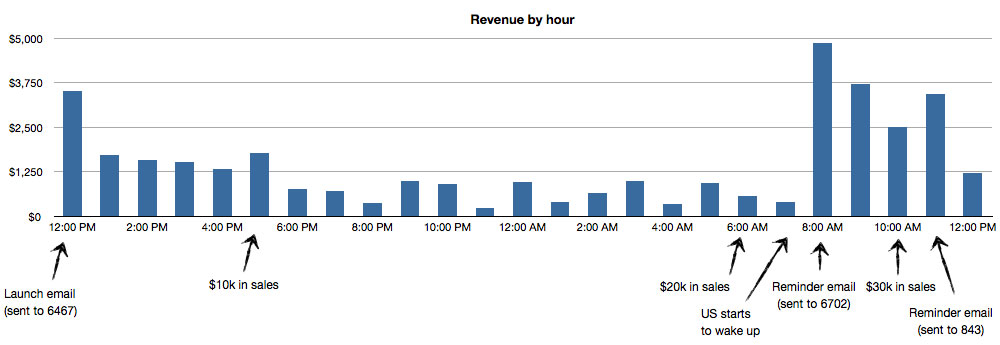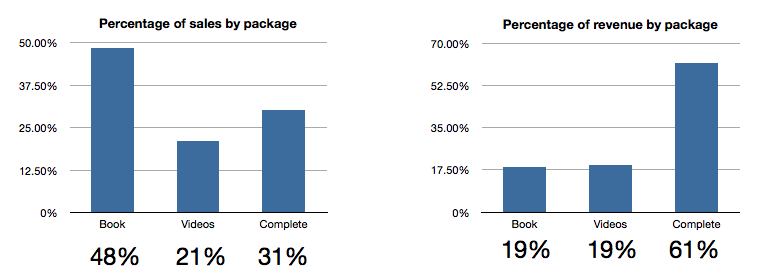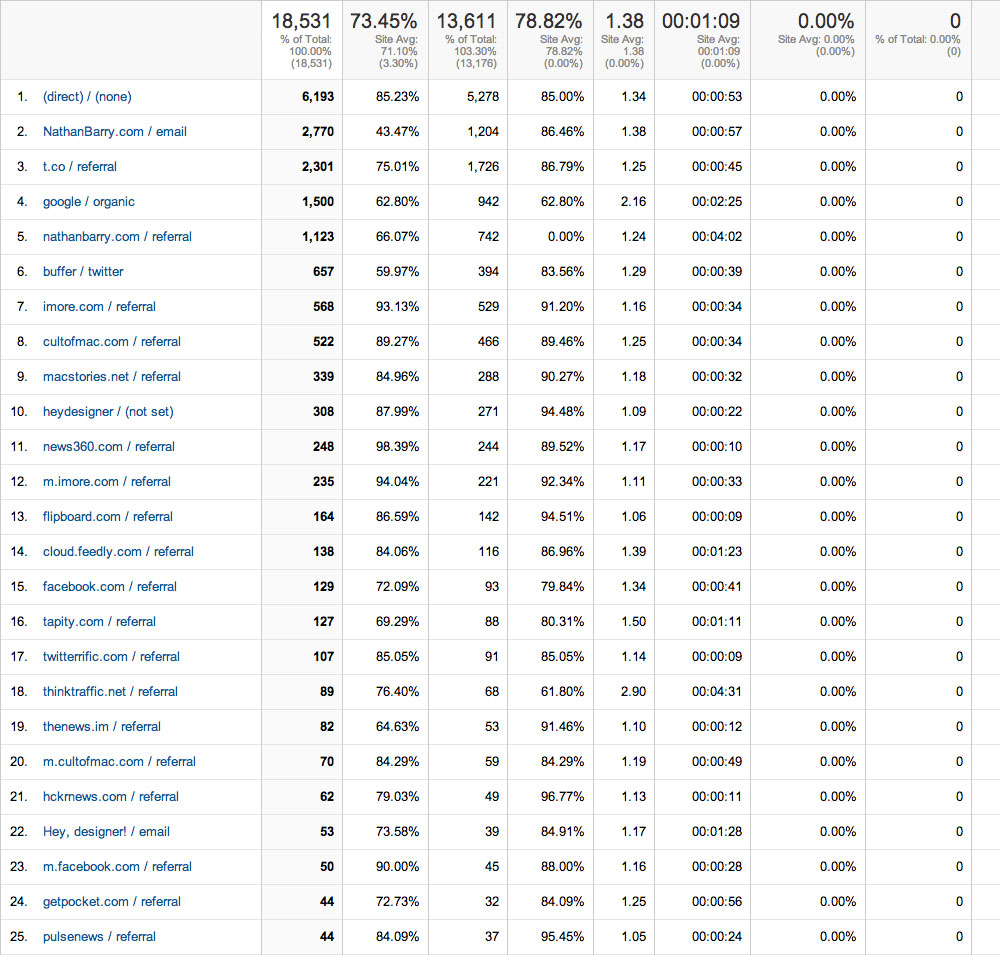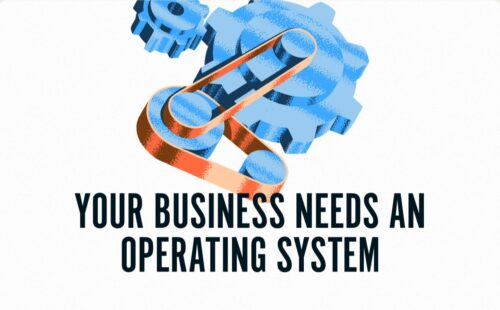Last Wednesday Jeremy Olson and I released the iOS 7 Edition of my first book, The App Design Handbook. It had been a few months in the making, and obviously built on the success of the original edition. What I didn’t expect is that it would beat every other launch I’ve done by a wide margin!
Check out the sales page, and pick up your own copy, here.
Setting the stage
When iOS 7 was announced I knew my book—which was almost a year old—would need a huge update. I started to work on the update, but had a hard time making time for it with my other projects—mostly ConvertKit and traveling/speaking at conferences. Sales had dropped off considerably down to about $1,000/month. Combined with my other books, it was still a meaningful amount of revenue, but declining further over time (as books tend to do).
I knew if I didn’t update the book it would continue to decline until it didn’t really make any money. Which would be expected, since the book would be quite out of date! Being unable to complete the new book, I turned to two friends, Caleb Wojcik and Barrett Brooks, in my mastermind group to see what I should do.
They said I really had two choices (other than updating the book myself, which was out):
- Not update the book, and eventually stop selling it.
- Find a co-author who will update it for a portion of revenue.
Based on their advice I set a short deadline to find a co-author (one week from then) and if I couldn’t, then I would let the book eventually be removed from sale.
Finding a co-author
I immediately started looking through everyone I respected in the iOS community. This ranged from people who had been blogging for a while (and brought their own audience) who would require a large revenue split to people who didn’t have an audience and would update the book for a fixed fee or a small percentage of revenue.
Overall I contacted about eight people and received regretful rejections from most of them. Just about everyone was too busy with their own projects (as good people are) and couldn’t work on the book on short notice. Though I ended up with three people who were interested and could be a good fit.
Then through office hours for ConvertKit I talked to Jeremy Olson. What was supposed to be a 20 minute call ended up at almost an hour—and we barely talked about ConvertKit! It turns out Jeremy was an Apple Design Award winning designer and, after reading Authority, wanted to write his own book on designing iOS apps.
He had already started acting on my strategy of packaging expert interviews with the top tier package to deliver even more value. Meaning he already had nine in-person interviews recorded and the list overlapped very closely with the list of people I wanted to interview!
Getting started
Jeremy had a target audience of iOS designers and developers he was bringing to the table, was already executing on my strategy, and had a long term plan to build products and an audience around designing iOS apps. It was a perfect fit!
We quickly decided on a 50/50 revenue split with him doing most of the work to update the book (I estimated about 30% of the text and 90% of the images needed to change) and add additional video content to the higher packages.
I worked on other projects (like teaching workshops in London and Boston), while Jeremy updated the book. We had to push the launch date back a bit, but finally settled on November 6th and stuck with it.
In the last five days we had to work like crazy to get the book out. We ended up missing our original launch deadline by a few hours, but that didn’t affect anything (other than stressing us out).
A little about the book
Now with some backstory out of the way I want to tell you a bit about the book before we dive into launch stats. I think it can be summed up well in these two quotes:
“I read the whole book last night – I liked it a lot! I am thrilled that there is finally a definitive guide for crafting excellent iOS user experiences, and it’s now up to date for iOS 7. Excellent work on this. I am excited to recommend it.”
– Joel Levin, iOS Developer at Storehouse
And Loren Brichter, the creator of Tweetie (bought by Twitter), Letterpress, and the creator of the pull-to-refresh design pattern, had this to say:
“A concrete guide to fantastic software design.”
– Loren Brichter
We also got great feedback and compliments from people inside Apple who, unfortunately, don’t give public quotes. But people love this book!
Launch stats
I’ve written about my previous three book launches in these posts, so you can read them for even more information:
Each launch has been bigger than the previous one, but I didn’t expect that trend to continue since this launch was a new edition and not an entirely new book. I’m happy to say, I was wrong!
Revenue first
Everyone is always most interested in revenue, so we’ll cover that first. In the first 24-hours Jeremy and I sold 548 copies of The App Design Handbook for $36,297 in gross revenue.

I find it interesting to break out the revenue by hour. Then you can see exactly when some important events (like emails being sent) happened.

All the times listed above are in Eastern time. About 5 hours into the launch we were able to pass $10k in revenue, but then it took 18 hours into the launch to hit $20k. Most of our sales came from the US, so they are heavily skewed to times of the day that the US is actually awake.
But what really makes the difference is when emails are sent. You can see sales are quite low until 8:00 AM Eastern when I sent a reminder email to 6,700 subscribers. I did the same thing during the launch of Authority and that also added a huge spike (hint: email is awesome). I then sent a third reminder email in the last hour, but this time to only people who had opted in specifically to hear about the iOS 7 edition of this book (about 800 subscribers). You can see that spike as well at 11:00 AM.
Let’s talk about email
Email marketing is the key to making an entire launch like this happen. It’s especially important to focus on the sequence leading up to launch day, without that done right, none of this would have happened.
Here’s the sequence for the launch:
- “An iOS 7 design case study” (sent to 5,671) — October 10, 2013
This was a detailed case study I wrote about redesigning my app Commit, for iOS 7. - “Reactions to iOS 7” (sent to 6,150) — October 31, 2013
A post Jeremy wrote early this summer that I republished to my blog and email list. - “Sneak Peek: Interview with Michael Flarup” (sent to 6,223) — November 4, 2013
Two days before launch, this sample interview helped build even more buzz. - “Slight change of plans” (sent to 6,198) — November 5, 2013
This email was to provide any last details about the upcoming launch and to say that we were launching at 11:00 AM Eastern instead of 8:00 AM Eastern. - “It’s Live” (sent to 6,467) — November 6, 2013
The launch email. It was actually split into two groups: those who had purchased the first edition (1,152) and those who hadn’t purchased before (5,315). One offered the upgrade pricing, the other advertised 20% off for the first 24 hours. - “Just 4 hours left” (sent to 6,702) — November 7, 2013
The reminder email that the sale will be ending soon. The subscriber count is larger on this one because I included everyone who had opted in to the sample chapter that day. - “20 minutes left” (sent to 843) — November 7, 2013
A final reminder about the sale ending that went out to everyone who had specifically expressed interest in this book (not just my entire design list). Also, each sale reminder email is filtered to exclude those who have already purchased.
As you can see it’s not as easy as just sending an email saying, “go buy the book!” You have to build up anticipation, answer questions, and send reminders to get a launch of this scale. None of that would have been possible without building up an email list first.
Social Media
One of the key factors in the unexpected success of this launch was Jeremy’s incredible network of influential app makers and journalists. Unlike my other launches, the book got tremendous coverage on sites like iMore, Cult Of Mac, and MacStories, driving lots of hits to the site and multiplying the buzz around the book. Those articles came about in large part because Jeremy already had great relationships with those sites.
Jeremy also reached out to a couple dozen extremely influential people in his network like Loren Brichter (Atebits), Evan Doll (Flipboard), and Geoff Teehan (Teehan + Lax). They not only were interested in copies of the book to give feedback on, but almost all of the people Jeremy contacted either tweeted about the book or retweeted Jeremy’s tweet, resulting in thousands of really hot hits to the site.
I had tried to reach out to many of these folks for the launch of the original book, without much luck. That just shows the value of having a co-author who has a great network in the industry (also, no one knew who I was the first time around).
Selling in multiple packages
If you’ve read anything I’ve written about making money from ebooks than you know how much I like selling in multiple packages to deliver more value and increase revenue. This launch was no exception. If you are trying to profit from a technical ebook I think this is a must follow strategy.
The breakdown in sales between the three packages was as follows:

The most interesting thing to note is that while the book ($29) accounted for 48% of copies sold, it was just 19% of revenue. And the complete package ($199) was only 31% of the copies, it accounted for 61% of revenue.
If I only sold the book, then the most anyone could pay me would be $29. But with the complete package those who want to pay more to get more design training can’t—meaning they will just spend $29—leaving a lot of money on the table.
I can actually calculate what would happen in that scenario: having just one package would have resulted in only $12,780 in sales. When we compare that to the actual $36,297 we learn that using multiple packages increased revenue by 2.8x! That matches my previous books where multiple packages have increased revenue by 2x for one, and 3x for the other two.
Launching a new edition
One big thing that was different between this launch and my previous launches was that is a new edition of a previous book. Because of that I thought most of my audience who wanted to purchase would have already, so it wouldn’t be as big. I was quite wrong. My audience was tiny (in comparison) when I first released The App Design Handbook and many people who have joined since then just haven’t bought the book. It’s easy to think that everyone has heard of all your products, but the truth is unless you actively promote it, many people won’t know it exists.
As an example a few months ago I was asking on Twitter and Facebook for case studies from people who had read Authority and launched their own book (The results are here). A surprising number of people commented or replied to say, “What’s Authority?”
Yikes, that means I wasn’t doing a very good job letting my own followers know what books I’d written. Meaning a lot of people in my audience probably hadn’t purchased The App Design Handbook—even if they knew it existed.
Upgrades
I’ve sold 1,152 copies of the first edition of The App Design Handbook and in the first 24 hours of the new edition, 166 people upgraded. Said another way, 14% immediately upgraded to the new edition at 70% off. Revenue from upgrades was $7,649 which accounted for 21% of total revenue.
I’m sure over time many more people will upgrade, especially since they are getting so much new content at the continued 70% discount.
Traffic
My blog averages between 30,000 and 40,000 visits per month. On launch day I received 10,000 visits! Here’s the traffic graph for the entire month:

Now let’s take a look at traffic source for November 6th and 7th to get a better idea of where traffic came from:

Beating the record
That about wraps up my launch post. It was a crazy couple of days—but I’m very happy to say that the launch total of $36,297 beat my previous 24-hour record (previously held by Authority at $26,872) by nearly $10,000!
That means each one of my launches has been bigger than the last as my audience and knowledge have increased. This money is of course split with Jeremy 50/50, whereas my previous launches were all my own revenue. I couldn’t be happier with how this launch has gone!
If you want to learn to write and sell books like I do, pick up a copy of Authority. And if you want to learn to design beautiful, iOS 7 ready apps, get a copy of The App Design Handbook: iOS 7 Edition.
Want to be able to launch like this?
Product launches are hard to get right, but when you do, the results are fantastic. In order to help with the process I wrote a detailed email course on Mastering Product Launches. It starts by teaching you the foundations and then walks you through how to do an actual launch. It’s free, and you can sign up with this form:


Love the Launch Sequence, Nathan and great work! Would like to see the copy you used in the emails.
Did you use ConvertKit to do the emails on this one?
Awesome stats. I’d have been very happy the stats of my apps are a third as good as yours.
Awesome work Nathan! Can’t wait to see your next launch :) Whats next? :)
Hey Nathan,
This is information is so tangible and actionable. Thank you for sharing so transparently.
The sequence of emails you used for your launch is pure gold for me.
I’m launching my own iOS programming video course in 8 days and I’ve been trying to follow your advice from Mastering Product Launches. I’ve got an email list of several thousand people and have been keeping touch.
I’m excited and nervous at the same time but I also hope to share my learnings and results from the launch.
Thanks
Chris
An unbelievable feat of strength my friend. Congrats!
Seems you really know how to do a very successful launch.
Epic post!
Great stuff Nathan!
You’ve been inspiring me for my own launch which is taking place December 15.
I’m excited, nervous, and working like crazy to complete my course on How to Build an Online Teaching Career.
Your blog and email course have been amazing.
Hi Nathan,
Thank you for sharing your approach with such transparency. I especially found it surprising how little traffic came from such high profile sites (ie. thinktraffic etc) – proves the importance of building an email list.
I’m definitely going to try this with my next product launch and if i get even half of your success I will very pleased.
*Watch this space*
Epic post. I love everything mentioned here. I am going to follow the same process for my app as well :)